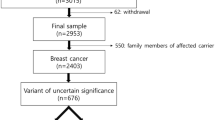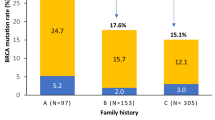Abstract
Germline mutations in the tumor suppressor genes BRCA1 and BRCA2 are responsible for a large proportion of familial breast cancer cases, and therefore, BRCA1 and BRCA2 genetic testing has become increasingly common in clinical practice. However, variants of uncertain significance (VUS) have been detected in 16.3% of Japanese patients suspected of having hereditary breast and ovarian cancers. The clinical importance of VUS is unknown, and their incidence has led to issues in risk counseling, assessment and treatment of cancer patients. In the present study, we performed functional analysess of two VUS in BRCA1, A1752G and Y1853C that were detected in two independent breast cancer patients who were suspected of having hereditary breast cancer. Segregation analysis revealed that Y1853C, but not A1752G, was cosegregated in affected family members. Conservation, transcription and structure analyses also supported the pathogenic potential of Y1853C. Detailed segregation and in silico and in vitro analyses will enhance our understanding of VUS and improve the management of cancer patients and their families.
Similar content being viewed by others
Log in or create a free account to read this content
Gain free access to this article, as well as selected content from this journal and more on nature.com
or
References
Matsuda, T., Marugame, T., Kamo, K., Katanoda, K., Ajiki, W. & Sobue, T. Cancer incidence and incidence rates in Japan in 2006: based on data from 15 population-based cancer registries in the monitoring of cancer incidence in Japan (MCIJ) project. Jpn J. Clin. Oncol. 42, 139–147 (2012).
Lancaster, J. M., Powell, C. B., Kauff, N. D., Cass, I., Chen, L. M., Lu, K. H. et al. Society of Gynecologic Oncologists Education Committee statement on risk assessment for inherited gynecologic cancer predispositions. Gynecol. Oncol. 107, 159–162 (2007).
Miki, Y., Swensen, J., Shattuck-Eidens, D., Futreal, P. A., Harshman, K., Tavtigian, S. et al. A strong candidate for the breast and ovarian cancer susceptibility gene BRCA1. Science 266, 66–71 (1994).
Wooster, R., Bignell, G., Lancaster, J., Swift, S., Seal, S., Mangion, J. et al. Identification of the breast cancer susceptibility gene BRCA2. Nature 378, 789–792 (1995).
Scully, R. & Livingston, D. M. In search of the tumour-suppressor functions of BRCA1 and BRCA2. Nature 408, 429–432 (2000).
Callebaut, I. & Mornon, J. P. From BRCA1 to RAP1: a widespread BRCT module closely associated with DNA repair. FEBS Lett. 400, 25–30 (1997).
Roy, R., Chun, J. & Powell, S. N. BRCA1 and BRCA2: different roles in a common pathway of genome protection. Nat. Rev. Cancer 12, 68–78 (2012).
Scully, R., Chen, J., Plug, A., Xiao, Y., Weaver, D., Feunteun, J. et al. Association of BRCA1 with Rad51 in mitotic and meiotic cells. Cell 88, 265–275 (1997).
Scully, R., Chen, J., Ochs, R. L., Keegan, K., Hoekstra, M., Feunteun, J. et al. Dynamic changes of BRCA1 subnuclear location and phosphorylation state are initiated by DNA damage. Cell 90, 425–435 (1997).
Sugano, K., Nakamura, S., Ando, J., Takayama, S., Kamata, H., Sekiguchi, I. et al. Cross-sectional analysis of germline BRCA1 and BRCA2 mutations in Japanese patients suspected to have hereditary breast/ovarian cancer. Cancer Sci. 99, 1967–1976 (2008).
Frank, T. S., Deffenbaugh, A. M., Reid, J. E., Hulick, M., Ward, B. E., Lingenfelter, B. et al. Clinical characteristics of individuals with germline mutations in BRCA1 and BRCA2: analysis of 10,000 individuals. J. Clin. Oncol. 20, 1480–1490 (2002).
Phelan, C. M., Dapic, V., Tice, B., Favis, R., Kwan, E., Barany, F. et al. Classification of BRCA1 missense variants of unknown clinical significance. J. Med. Genet. 42, 138–146 (2005).
Ng, P. C. & Henikoff, S. Predicting deleterious amino acid substitutions. Genome Res. 11, 863–874 (2001).
Adzhubei, I. A., Schmidt, S., Peshkin, L., Ramensky, V. E., Gerasimova, A., Bork, P. et al. A method and server for predicting damaging missense mutations. Nat. Methods 7, 248–249 (2010).
Sali, A. & Blundell, T. L. Comparative protein modelling by satisfaction of spatial restraints. J. Mol. Biol. 234, 779–815 (1993).
Shiozaki, E. N., Gu, L., Yan, N. & Shi, Y. Structure of the BRCT repeats of BRCA1 bound to a BACH1 phosphopeptide: implications for signaling. Mol. Cell 14, 405–412 (2004).
Bergthorsson, J. T., Ejlertsen, B., Olsen, J. H., Borg, A., Nielsen, K. V., Barkardottir, R. B. et al. BRCA1 and BRCA2 mutation status and cancer family history of Danish women affected with multifocal or bilateral breast cancer at a young age. J. Med. Genet. 38, 361–368 (2001).
Lee, M. S., Green, R., Marsillac, S. M., Coquelle, N., Williams, R. S., Yeung, T. et al. Comprehensive analysis of missense variations in the BRCT domain of BRCA1 by structural and functional assays. Cancer Res. 70, 4880–4890 (2010).
Rowling, P. J., Cook, R. & Itzhaki, L. S. Toward classification of BRCA1 missense variants using a biophysical approach. J. Biol. Chem. 285, 20080–20087 (2010).
Williams, R. S., Chasman, D. I., Hau, D. D., Hui, B., Lau, A. Y. & Glover, J. N. Detection of protein folding defects caused by BRCA1-BRCT truncation and missense mutations. J. Biol. Chem. 278, 53007–53016 (2003).
Humphrey, J. S., Salim, A., Erdos, M. R., Collins, F. S., Brody, L. C. & Klausner, R. D. Human BRCA1 inhibits growth in yeast: potential use in diagnostic testing. Proc. Natl Acad. Sci. USA 94, 5820–5825 (1997).
Carvalho, M. A., Marsillac, S. M., Karchin, R., Manoukian, S., Grist, S., Swaby, R. F. et al. Determination of cancer risk associated with germ line BRCA1 missense variants by functional analysis. Cancer Res. 67, 1494–1501 (2007).
Acknowledgements
We are grateful to the patients and their family members who participated in this study. We also thank Dr Yoshihiro Miwa, University of Tsukuba, for his valuable comments on the transactivation assay.
Author information
Authors and Affiliations
Corresponding author
Ethics declarations
Competing interests
The authors declare no conflict of interest.
Additional information
Supplementary Information accompanies the paper on Journal of Human Genetics website
Rights and permissions
About this article
Cite this article
Kawaku, S., Sato, R., Song, H. et al. Functional analysis of BRCA1 missense variants of uncertain significance in Japanese breast cancer families. J Hum Genet 58, 618–621 (2013). https://doi.org/10.1038/jhg.2013.71
Received:
Revised:
Accepted:
Published:
Issue date:
DOI: https://doi.org/10.1038/jhg.2013.71
Keywords
This article is cited by
-
Correlation between the risk of ovarian cancer and BRCA recurrent pathogenic variants in Japan
Journal of Human Genetics (2022)



